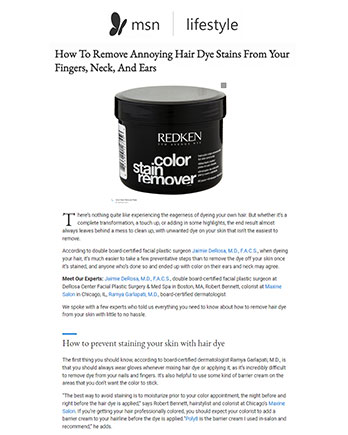MSN February 28, 2023
 MSN
MSN
Lifestyle
How To Remove Annoying Hair Dye Stains From Your Fingers, Neck, And Ears
There’s nothing quite like experiencing the eagerness of dyeing your own hair. But whether it’s a complete transformation, a touch up, or adding in some highlights, the end result almost always leaves behind a mess to clean up, with unwanted dye on your skin that isn't the easiest to remove.
According to double board-certified facial plastic surgeon Jaimie DeRosa, M.D., F.A.C.S., when dyeing your hair, it’s much easier to take a few preventative steps than to remove the dye off your skin once it’s stained, and anyone who’s done so and ended up with color on their ears and neck may agree.
Meet Our Experts: Jaimie DeRosa, M.D., F.A.C.S., double board-certified facial plastic surgeon at DeRosa Center Facial Plastic Surgery & Med Spa in Boston, MA, Robert Bennett, colorist at Maxine Salon in Chicago, IL, Ramya Garlapati, M.D., board-certified dermatologist
We spoke with a few experts who told us everything you need to know about how to remove hair dye from your skin with little to no hassle.
How to prevent staining your skin with hair dye
The first thing you should know, according to board-certified dermatologist Ramya Garlapati, M.D., is that you should always wear gloves whenever mixing hair dye or applying it, as it’s incredibly difficult to remove dye from your nails and fingers. It's also helpful to use some kind of barrier cream on the areas that you don't want the color to stick.
“The best way to avoid staining is to moisturize prior to your color appointment, the night before and right before the hair dye is applied,” says Robert Bennett, hairstylist and colorist at Chicago's Maxine Salon. If you’re getting your hair professionally colored, you should expect your colorist to add a barrier cream to your hairline before the dye is applied. “Poly8 is the barrier cream I used in-salon and recommend,” he adds.
If you're taking the at-home route, Dr. DeRosa suggests putting a protective layer of petroleum jelly or mineral oil at the edges of the hairline and ears to keep the dye from penetrating the skin and staining it. “It’s also helpful to keep your skin as hydrated as possible before dyeing your hair, as dry skin soaks up the dye more easily,” she explains.
You should also remember that when applying petroleum jelly, only apply it to the areas you’re trying to keep dye-free, as getting any of it on your hair will not cause the hair dye not to work properly.
How to remove hair dye from your skin
One of the best ways to remove dye from the skin is to be sure to wipe away any drops or smudges during the coloring process. Bennett recommends grabbing a cotton pad and rubbing the stained area with a stain or dye remover. “My favorite product is Redken Stain Remover; the pads are included and already saturated, an easy all-in-one,” he explains.
You can also use any stain remover you can get your hands on. Just soak a cotton ball with the remover and gently wipe the stained areas. “Baby wipes or even petroleum jelly can also be used to help remove the dye from the skin ," Dr. DeRosa explains. "Just massage it into your skin, which will absorb the dye into the petroleum jelly.”
How can hair dye impact the skin?
Aside from it not looking the best, according to Dr. DeRosa, hair dye doesn't usually pose any big risk to the skin, but it can cause redness and itchiness. “If you’re concerned about a rash or particular skin condition, be sure to consult with your doctor,” she suggests. Luckily, even if you don’t act quickly to remove the dye from your skin, it's likely to fade away in a just few days.
“Certain dyes contain PPD, which is a well-known allergen that can cause a rash in certain individuals when it comes into contact with the skin,” Dr. Garlapati explains. Hair dye can cause your skin and scalp to itch, but you may also experience skin irritation as a result of rubbing your skin to remove the color. Ensuring you’re thoroughly getting the dye out of your hair while washing it can help you avoid this entirely.
